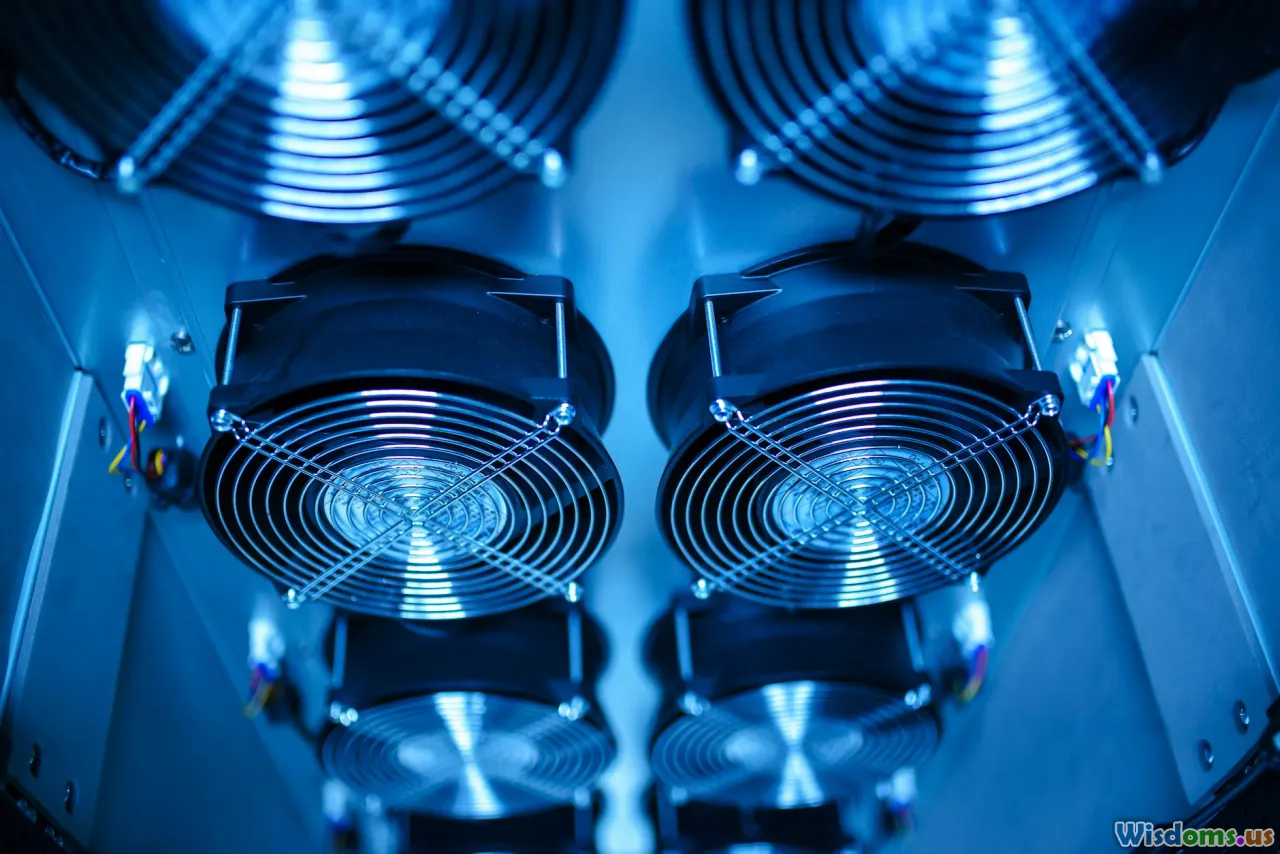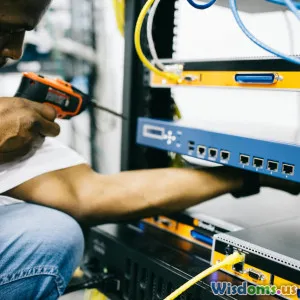
Surprising Factors Destroying Server Room Efficiency Explained
13 min read Unveils overlooked culprits behind server room inefficiency, offering actionable insights to boost reliability, lower costs, and optimize performance. (0 Reviews)
Surprising Factors Destroying Server Room Efficiency Explained
Server rooms are the nerve centers of modern organizations, silently empowering day-to-day business operations, from critical data management to seamless application delivery. Yet, many server rooms limp along at a fraction of their true potential—and not always for obvious reasons.
Could subtle, easily overlooked factors be sabotaging your server room efficiency?
In this article, we'll dig deep into surprising culprits behind server room inefficiency. We’ll detail why these issues are often ignored, show the real impact they have, and—most importantly—empower you with actionable strategies to reclaim reliability, performance, and cost-effectiveness.
Table of Contents
- Why Server Room Efficiency Really Matters
- 1. The Invisible Threat: Airflow Obstruction
- 2. Dust and Contaminants: The Silent Performance Killers
- 3. Humidity and Temperature Fluctuations
- 4. Cabling Chaos and Poor Organization
- 5. Human Error: The Underestimated Efficiency Saboteur
- 6. Neglected Power Management
- 7. Overlooking Environmental Monitoring
- Conclusion: Turning Insight Into Action
Why Server Room Efficiency Really Matters
It’s easy to see server room efficiency as a technical curiosity best left to IT staff. But the real-world consequences of an inefficient server room are universal and urgent:
- Downtime: Inefficient operations translate directly to unexpected outages. Gartner famously pegs the average cost of IT downtime at $5,600 per minute.
- Energy Waste: According to the U.S. Department of Energy, data centers/shared IT rooms account for about 2% of total electricity use in the U.S—more than some nations.
- Thermal Runaway: Heat and inefficiency often walk hand in hand. Overheated servers degrade faster, shorten hardware lifespans, and rack up replacement costs.
Now, let’s dissect the factors hiding in plain sight that destroy efficiency.
1. The Invisible Threat: Airflow Obstruction
Hotspots aren’t just for WiFi—they’re critical inefficiencies in your server room.
Misplaced Equipment and Blocked Vents
Server racks are designed for cooling efficiency, with airflow precisely channeled from front to back. But just a few misaligned devices or closed-off vents can skew this balance:
- Stacking Boxes or Miscellaneous Items: It’s common (but dangerous) to store supplies atop racks or near airflow intakes.
- Improperly Mounted Equipment: Servers jammed too close together or not aligned within racks create dead zones for heat buildup.
- Cables Bundled in Front of Fans: Bulk cable spools restrict airflow.
A case reported by the Uptime Institute traced a series of minor outages at a healthcare provider’s data room back to improper vent/cooling arrangement—traceable in photos to something as mundane as cardboard boxes.
Underfloor and Overhead Obstacles
For rooms equipped with raised flooring:
- Cables, power strips, or debris underfloor can block cool air, rendering CRAC (computer room air conditioning) systems less effective.
Solution: Conduct quarterly airflow audits with thermal imaging. Remove obstructions and ensure compliance with original rack and cooling designs.
“The most effective airflow arrangement is rapidly undone by the smallest blockage,” notes Lisa Easterly, facilities consultant at Datacenter Dynamics.
2. Dust and Contaminants: The Silent Performance Killers
It’s easy to underestimate the cumulative effect of dust—yet, according to ASHRAE (American Society of Heating, Refrigerating and Air-Conditioning Engineers), airborne particulates are a top cause of server failure.
How Dust Destroys Efficiency
- Blockage: Dust accumulates on fan intakes and heat sinks, impeding airflow, trapping heat, and forcing fans to work harder.
- Corrosion: Fine particles accelerate corrosion, especially when combined with humidity, leading to premature circuit board failure.
- Short Circuits: Metallic dust particles, such as those from recently drilled concrete or florescent light fixtures, can bridge connections, damaging boards.
A banking firm in Chicago lost half a rack’s worth of production servers over one summer solely due to construction dust entering via improper vent sealing—an avoidable, six-figure disaster.
Mitigation Strategies
- Establish Controlled Cleaning Protocols: Only trained personnel using anti-static equipment should clean server areas—never regular janitorial staff.
- Replace HVAC Filters Frequently: More so if building works or heavy foot traffic increases dust load.
- Positive Pressurization: Some facilities use slightly positive air pressure to keep contaminants at bay.
3. Humidity and Temperature Fluctuations
Stability is the unsung hero of IT reliability. Many assume as long as the server room is "cool enough," all is well. But it’s variation, not absolute temperature, that causes trouble.
Examples of Fluctuations Wreaking Havoc
- Sudden Cooling/Fan Failure: Servers exposed to cycles of hot-cool expansion/contraction experience microfractures in circuit boards—leading to solder failure.
- Wrong Humidity: If it falls below 40%, static electricity threatens hardware; higher than 60%, and condensation risks increase.
A case reported by Schneider Electric detailed how the adoption of an energy-saving 'night mode' in an office building inadvertently led to wild temperature swings after hours, causing recurrent hardware failures.
Practical Prevention
- Invest in Data Loggers: Deploy sensors throughout the room, not just at the thermostat.
- Don’t Rely on Building Control Alone: Supplement with server room–specific HVAC.
- Review Humidity Controls: Maintain between 45-55% RH whenever possible.
4. Cabling Chaos and Poor Organization
A spaghetti mess of cables isn’t just ugly—it’s costly.
Impacts of Inadequate Cable Management
- Restricted Airflow: As mentioned, tangled cables act like heat-trapping nests around racks and devices.
- Inefficient Troubleshooting: Locating a malfunctioning lead can take hours longer—expensive hours when downtime is on the line.
- Error Prone Moves: Poor labeling and messy patch panels lead to accidental disconnections.
A data center survey from Emerson Network Power found that, on average, up to 10% of unscheduled downtime is attributable to unplanned cable disconnects and trace errors.
Proven Solutions
- Structured Cabling Systems: Invest in colored patch cords, sleeved bundles, and properly labeled ends.
- Cable Trays: Keep bulk runs off the floor and ceiling with designated raceways and trays.
- Adopt A ‘One In, One Out’ Policy: For every new or rerouted cable, remove an obsolete one.
5. Human Error: The Underestimated Efficiency Saboteur
It’s tempting to focus solely on the environment, yet studies show that human error causes upward of 20-30% of IT downtime (Ponemon Institute, 2021).
Typical Efficiency-Killing Human Mistakes
- Poor Change Management: Ad-hoc hardware installs, quick fixes, or undocumented changes leave lasting, hidden problems.
- Incomplete Training: Staff unfamiliar with hot-swappable components, correct shutdown/startup, and redundancy procedures compound risks.
- Neglect or Complacency: Routine tasks get skipped—like not checking battery backup units or letting documentation go stale.
Anecdote
After an office move, a regional law firm saw three outages traced to a single untrained junior staffer plugging in small desktop heaters directly to the same circuit as the UPS feed—overloading it.
Creating a Culture of Reliability
- Comprehensive Documentation: Always update rack diagrams and asset registers immediately during any change.
- Mandatory Training: Regular refreshers for anyone with server room access.
- Checklists For Every Task: Even seemingly minor work should trigger a review (power, cooling, physical arrangement).
"Technology can outlast configurations, but unmanaged human intervention is always a wildcard," warns Sarah Cobb, infrastructure lead at Verum Tech.
6. Neglected Power Management
Power losses and sags don’t always manifest as full-blown outages—but their hidden costs add up swiftly.
Common Overlooked Issues
- Outdated Uninterruptible Power Supplies (UPS): Batteries degrade yet often aren’t refreshed on schedule. "Phantom reliability"—UPS that don’t actually hold a charge—endanger business continuity.
- Single Points of Failure: Daisy-chaining power strips or running every device off a limited number of circuits.
- Inadequate Surge Protection: Spikes from nearby heavy equipment trigger subtle malfunctions and gradual hardware damage.
Data Spotlight
The Ponemon Institute's "Cost of Data Center Outages" report (2022) found power-related events accounted for 43% of all unplanned outages, far outstripping even hardware failure.
What You Can Do
- Implement Tiered Power Distribution: Separate databases, storage, and networking onto independent power feeds.
- Routine UPS Testing: Initiate monthly test cycles and planned battery replacements.
- Surge and Lightning Protection: Choose enterprise-rated suppression designed specifically for server room environments.
7. Overlooking Environmental Monitoring
If you can’t measure it, you can’t manage it.
A surprising number of server rooms run “blind,” relying on guesswork for temperature, humidity, or airflow analytics.
Signs of Inadequate Monitoring
- Reactive, Not Proactive: Problems surface only after a device fails.
- Localized Issues Go Unnoticed: Small hotspots or drafts eventually snowball into full-room problems.
- No Alerting or Remote Notice: Staff are unaware of environmental threats on weekends/holidays.
The Modern Approach
- Deploy Sensor Arrays: Affordable IoT-based sensors can track and report metrics in real-time, often through cloud dashboards or email/SMS alerts.
- Set Upper and Lower Alarm Thresholds: Don’t just monitor—act on out-of-place readings, even if they're minor.
- Integrate With BMS Platforms: Link readings to building management or IT ticketing systems for immediate response.
A European logistics firm saw a 60% reduction in downtime after implementing real-time alerts—often catching leakages or AC failures before they harmed even a single server.
Conclusion: Turning Insight Into Action
Server rooms are complex, unforgiving environments where efficiency is constantly under siege from surprising and often invisible sources. The good news? The majority of these issues are preventable with awareness, regular inspection, and a culture of documentation and discipline.
Key takeaways:
- Regular airflow assessments and strategic cable management fight heat and chaos.
- Design effective cleaning and contaminant control measures beyond ordinary housecleaning.
- Actively monitor for subtle environmental changes—even small swings matter.
- Embed reliability in your company culture via training, checklists, and mainstreaming change management.
- Stagger power loads and never trust untested backup systems.
By recognizing and proactively eliminating these subtle saboteurs, you can unlock both cost savings and heightened reliability—transforming your server room from a weak link into a high-performing nexus that powers your organization forward.
Take a fresh look at your server room today. The next efficiency breakthrough may be hiding in plain sight.
Rate the Post
User Reviews
Popular Posts


















